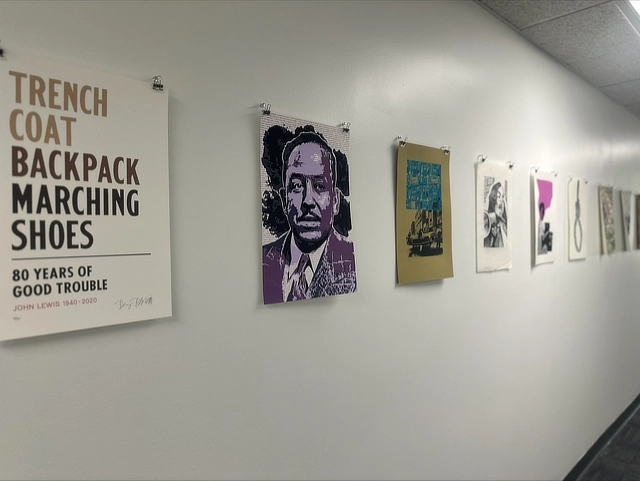
Geoff Sciacca, associate professor in Samford University’s School of the Arts, has recently coordinated the installment of a unique and original art exhibit that is currently on display on the third floor of Dwight Beeson Hall. Creativity and a call-to-action come alive in this colorful collection of works from more than 40 diverse artists across the United States and Puerto Rico.
The collection titled “The Dream Deferred” draws inspiration from the Langston Hughes’ poem “Harlem” and focuses on global social justice and diversity.
“Art is a mirror that has the ability to reflect back to the viewer things in our world as viewed through different lenses, as well as things about themself that they may not be able to see, or want to see,” said Sciacca. “I would hope that viewers, through the beauty of creative artistic expression, have a moment to sit with the challenge of what needs to change. There is beauty and brokenness in the world we live in, and each of these shows look at both characteristics through a myriad of different lenses.”
The collection seeks to inspire viewers to think deeply about the social issues that plague many communities across the United States and the globe.
“It is Samford’s Christ-centered mission, that makes a collection like this so important to display. Our students will go out from here attempting to make the world a better place, regardless of their profession, and it is our job as educators to prepare them for this responsibility. That includes addressing matters of the heart as well as the mind,” said Denise Gregory, associate provost for student success and diversity.
On display are actually two collections, “The Dream Deferred” and “The Dream (Is Still) Deferred.” The first collection arose out of the civic unrest following the death of George Floyd during the summer of 2020. The second collection developed out of an opportunity to more broadly showcase injustices across the world, and the need for global justice and equality.
“For ‘The Dream Deferred,’ diverse printmakers responded to the prompt to create a piece offering commentary on racial injustice and inequality in the United States. More than three fourths of the artists were BIPOC printmakers, and the work represents a number of different printmaking methodologies,” said Sciacca. “The second show is one that I organized in partnership with Atlanta-based printmaker/artist Jamaal Barber that opened the premise of the first collection of work to be more broadly about injustice and inequality in our world. Intended to be a smaller show, and building on the work of the first, this show allows artists to respond to some of the same issues as the first exhibition, while also examining the needs for justice and equality outside of the U.S. and including diversity that’s not exclusively racial.”
The collection represents a colorful tapestry of storytelling. Threads of brokenness and injustice are visible throughout every work, as well as threads of the need of love and unity.
“It’s all been a meaningful project to organize, be a part of, and to see come together,” said Sciacca. “It’s been an amazing opportunity to collaborate with so many different artists who work under the same umbrella description, all being printmakers, who work so differently with some of the same media. Likewise, the way each artist works when given the same general prompt is reflective of the diversity of experiences, critical and interpretive thought, and creativity. In both exhibitions, many of the participants were artists I did not even know, but this created a context to network and build connections with other like-minded artists.”
The exhibition will be on display for the remaining of the spring semester. According to Sciacca, visitors can expect to see a collection of 45 artistic expressions that are as diverse as the artists that created them.